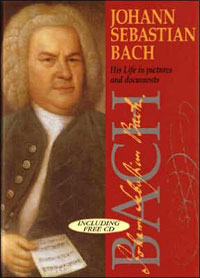Book Notes
 Hans Conrad Fischer, Johann Sebastian Bach; His Life in Pictures and Documents, with CD (Holzgerlingen, Germany: Hänssler Verlag, 1985, 2000), 193pp.
Hans Conrad Fischer, Johann Sebastian Bach; His Life in Pictures and Documents, with CD (Holzgerlingen, Germany: Hänssler Verlag, 1985, 2000), 193pp.
In this simply written and beautifully appointed volume Hans Fischer has provided a general overview of the life and times of one of the greatest composers ever to live. This is no substitute for the likes of Christoph Wolff's massive (600 pages) intellectual biography Johann Sebastian Bach: The Learned Musician, but for that very reason it is all the more accessible and enjoyable for the non-specialist. Fischer concentrates on Bach's life and times, and there is little analysis of his music per se. Born in Eisenach, home of the famous Wartburg Castle where Luther translated the Bible into German while imprisoned, Bach (1685–1750), was the youngest son of a family of eight children (four of whom survived). By age 10 both his mother and father died within a year, so the orphan Bach was raised by his brother. In his own two marriages he fathered 17 children.
Fischer insists that to understand Bach you must move beyond mere technical or intellectual analysis and grasp the centrality of Bach's deeply held (Lutheran) Christian faith. His organizing theme is that, in Bach's own words, the composer's lifelong goal was a "regulated sacred music to God's honor." His life was centered around the daily prayers, life, and worship of the local church. Indeed, writes Fischer, Bach "completely subordinated himself to the liturgy." At the top of many of his compositions Bach wrote the letters "JJ" (Jesu juva, Jesus help), and at the end, of course, the three letters "SDG" (Soli Deo Gloria, for the glory of God alone).
The subtitle of this book is important. Perhaps a full third of the book includes gorgeous plates of autographed manuscripts, engravings of churches and towns, period portraits of people close to Bach, along with important primary documents. For example, it is common knowledge that Bach came from a long line of family musicians; Fischer includes the entire Origin of the Musical Bach Family in which Bach documented what he knew about his 53 ancestors back to the sixteenth century and Vitus Bach, a baker in Hungary. Or again, it is fun to read the city council of Leipzig's Contract of Employment as the Cantor of St. Thomas's (where Bach spent 27 years). Among the 14 enumerated points: "That I will make music in the two major city churches as well as I can" (#2), and, "That I will not leave town without the Mayor's permission" (#13). For about $1300 you might purchase Hänssler Classic's 172 CDs of the Edition Bachakademie (the complete works of Bach). Or buy this book and enjoy the delightful CD that comes with it, A Musical Journey Through the Life of Johann Sebastian Bach, which includes 17 extracts from the Hänssler edition.


